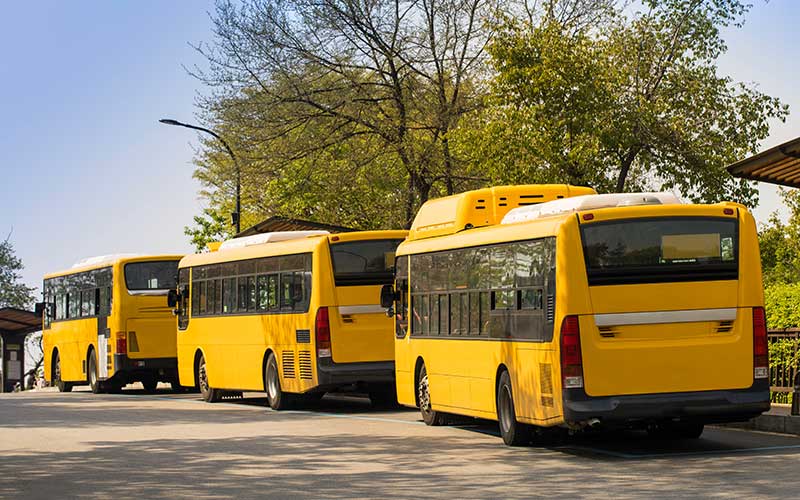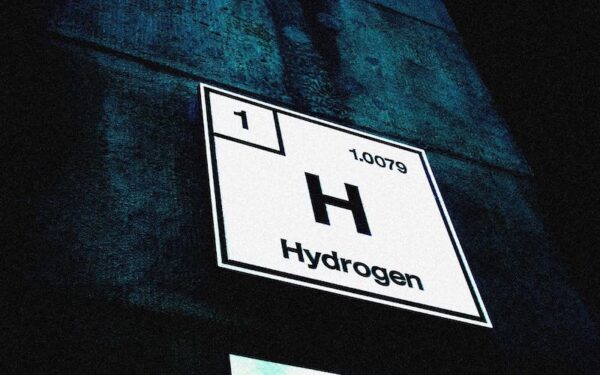
Electric school buses don't spew toxic pollution like those fueled by dirty fossil fuels – that's good for the health of our children and our communities as a whole. Photo: Jung U via Shutterstock
When the Centers for Disease Control and Prevention announced that vaccinated people could walk outside safely without masks, I grabbed my shoes and hit the sidewalk. But my nose was not quite prepared for the dirty air that awaited it. Dust and pollen itched and tickled. Humidity clogged thick in my nostrils, or dry air burned through them. Mostly though, I noticed the virulent smell of tailpipe fumes enveloping me in clouds of hot exhaust.
It likely comes as no surprise that exhaust fumes from vehicle tailpipes harm human health and the environment. They contain toxins that lead to increased disease and death for those who regularly breathe them. They also emit climate-damaging pollution. Even worse, those facing the greatest health risks are already our most vulnerable, such as children and people living in communities overburdened by air pollution.
The good news is that the issue of tailpipe exhaust – especially from buses – has finally gained the attention of policymakers across the country. The clear solution to this dirty problem: electric bus fleets.
Tailpipe fumes harm human health. Electric buses don’t.
Exposure to tailpipe fumes over time can have severe and even deadly consequences. But alternative fuels like propane and compressed natural gas come with their own dangers. Like diesel and gasoline, they emit harmful pollutants when burned, including particulate matter, methane, nitrogen oxides, carbon monoxide, and sulfur dioxide.
These pollutants cause and worsen diseases like asthma, bronchitis, and chronic obstructive pulmonary disease. They also increase the risk of heart disease, premature death, and even COVID-19. Children are especially vulnerable because they inhale up to three times more air per pound than adults.
Because of these dangers, many states have laws that limit excess vehicle idling. Unfortunately, these laws are rarely enforced. That’s why CLF holds bus companies across New England accountable when they flout these laws. Our successful lawsuits against school bus operators Transdev Services and DATTCO, Inc. will improve air quality and stop unnecessary bus idling. CLF’s lawsuits against bus operators Academy Express, Paul Revere Transportation, and All-Star Transportation are ongoing.
We must stop illegal vehicle idling to protect ourselves and our children. Ultimately, the best way to do that will be by replacing polluting, gas-powered buses with fully electric ones. Our almost $2 million settlement with DATTCO requires the company to purchase at least five electric school buses for its Connecticut fleet – a start for the company to make a complete transition from dirty fuels to electricity.
Polluting buses worsen the climate crisis, and electric fleets are crucial in the fight against it
Electric buses are not just kind to our lungs and overall health. They also help to prevent the climate crisis from worsening. Transportation makes up approximately 40% of climate-damaging emissions in the Northeast. Buses are a significant source of those emissions, whether they run on diesel, gasoline, propane, or natural gas.
Getting out of our vehicles and onto public transit is an essential step in fighting the climate crisis. But that effort will prove fruitless if our buses still heavily pollute our air and climate.
And, while our electricity sources in New England may not be 100% clean right now, the pollution caused by such energy usage will ebb over time as more renewable sources connect to the grid. This is especially true in states with legal commitments to lower their carbon pollution (Massachusetts, Connecticut, Vermont, Maine, and Rhode Island). In 2020, 30% of Massachusetts’ total in-state generation came from renewables.
What’s more, electric buses can even store and send energy back to the grid through so-called “vehicle-to-grid” programs. For example, school buses can be hooked up to the grid when they’re not in use, providing clean energy when electricity demand peaks. Successful vehicle-to-grid pilot programs exist already across the country, including one in Beverly, Massachusetts.
And, while vehicle-to-grid technology is still emerging, successful electric bus pilot programs have taken off nationwide for the past few years, from California and Oregon to New York and Virginia.
Electric buses offer a realistic solution that helps our health and environment
Currently, electric buses can cost more upfront than diesel ones – starting at around $300,000 for a school bus compared to $100,000 for diesel. However, that cost gets offset over the vehicle’s lifetime through maintenance, fuel, and operational savings. Other savings will come through reduced healthcare costs due to improved public health. And the upfront cost will decline as the technology becomes more prevalent.
No one should walk out their door and be assaulted by toxic fumes when alternatives exist. Electrification of our buses is on a steep upward trend – one that you can help push even higher. Now is our chance to let our legislators know what we value and urge them toward clean air for all.
In Massachusetts, our legislators are considering several bills to promote the electrification of school buses, including An Act to Promote Electric Vehicle Fleets by 2035 and An Act Promoting Zero-Emission Vehicles. If you live in Massachusetts, contact your legislators to ask them to support H.3255 / S.2139 and H.3347 / S.2151.
Elsewhere across New England, as climate action plans are put into place, make sure your legislators know that you want them to prioritize clean fleets for schools and public transportation.




